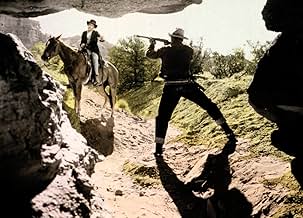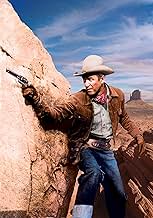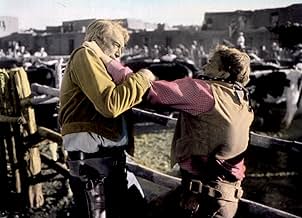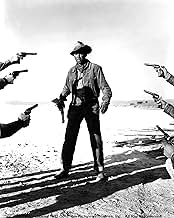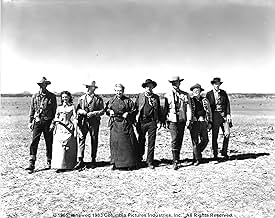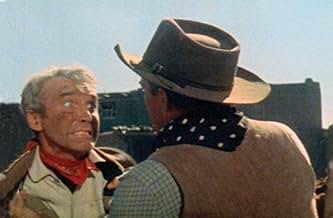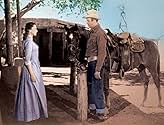VALUTAZIONE IMDb
7,3/10
12.746
LA TUA VALUTAZIONE
Il nuovo arrivato Will Lockhart sfida il magnate del bestiame locale e suo figlio sadico lavorando per uno dei suoi più vecchi rivali.Il nuovo arrivato Will Lockhart sfida il magnate del bestiame locale e suo figlio sadico lavorando per uno dei suoi più vecchi rivali.Il nuovo arrivato Will Lockhart sfida il magnate del bestiame locale e suo figlio sadico lavorando per uno dei suoi più vecchi rivali.
- Regia
- Sceneggiatura
- Star
Beulah Archuletta
- Woman at Indian Wedding
- (non citato nei titoli originali)
Jack Carry
- Mule Driver
- (non citato nei titoli originali)
Bill Catching
- Mule Driver
- (non citato nei titoli originali)
Frank Cordell
- Mule Driver
- (non citato nei titoli originali)
Recensioni in evidenza
Some of the best Westerns of the fifties were those directed by Anthony Mann and John Ford, straightforward and unpretentious, but each with an interesting approach to the requirements of the genre... Mann's films were the more prestigious, usually featuring James Stewart who, with John Wayne, was the fifties' biggest box-office draw... "The Man From Laramie" best known because of the Frankie Laine theme strong which accompanied it, is notable for (among other things) Alex Nicol's extraordinary projection of sadism, an element which dominated the best of Mann's movies... The motion picture was to be the last of the Mann-Stewart Westerns...
Stewart is cast as a wagon handler from Laramie, Wyoming, but is, really, an army officer out to avenge the death of his younger brother, a U.S. Cavalryman, massacred by the Apaches who were buying guns from unknown persons... It is these persons that Stewart is looking for..
Soon Stewart gets involved in an area of New Mexico which is ruled by the iron hand of a cattle baron Donald Crisp, a strong authoritarian "who can't live with a lie"... Crisp's one weakness is his love and care for his spoiled son, Alex Nicol...
Wild but feeble, yet vicious, Nicol - with extraordinary projection of sadism - accosts Stewart in several confrontations in which (among other outrages) Stewart is dragged through fire by horses, and has his hand held tight while Alex puts a bullet through it... Mann proceeds in this mood throughout the movie, growing even more sadistic...
Arthur Kennedy, a hard-working heavy, plays the adopted son of Crisp... He is a son in disguise, jealous of Alex, pretending to be his brother's ally and protector...
A lot of good supporting actors are cast including Cathy O'Donnell, the fragile beauty who has little to do but await patiently for an opportunity; Aline MacMahon, the fine 'ugly' woman who never leaves the old man, and Jack Elam who tries to knife James Stewart in the back...
Anthony Mann adopted an altogether tougher approach to Western mythology than John Ford... His obsessive, neurotic characters and his emphasis on violence foretell the work of Peckinpah, Leone and Eastwood...
Filmed in Technicolor, "The Man From Laramie" is a Western with new touches of brutality touching off the wide screen spectacle...
Stewart is cast as a wagon handler from Laramie, Wyoming, but is, really, an army officer out to avenge the death of his younger brother, a U.S. Cavalryman, massacred by the Apaches who were buying guns from unknown persons... It is these persons that Stewart is looking for..
Soon Stewart gets involved in an area of New Mexico which is ruled by the iron hand of a cattle baron Donald Crisp, a strong authoritarian "who can't live with a lie"... Crisp's one weakness is his love and care for his spoiled son, Alex Nicol...
Wild but feeble, yet vicious, Nicol - with extraordinary projection of sadism - accosts Stewart in several confrontations in which (among other outrages) Stewart is dragged through fire by horses, and has his hand held tight while Alex puts a bullet through it... Mann proceeds in this mood throughout the movie, growing even more sadistic...
Arthur Kennedy, a hard-working heavy, plays the adopted son of Crisp... He is a son in disguise, jealous of Alex, pretending to be his brother's ally and protector...
A lot of good supporting actors are cast including Cathy O'Donnell, the fragile beauty who has little to do but await patiently for an opportunity; Aline MacMahon, the fine 'ugly' woman who never leaves the old man, and Jack Elam who tries to knife James Stewart in the back...
Anthony Mann adopted an altogether tougher approach to Western mythology than John Ford... His obsessive, neurotic characters and his emphasis on violence foretell the work of Peckinpah, Leone and Eastwood...
Filmed in Technicolor, "The Man From Laramie" is a Western with new touches of brutality touching off the wide screen spectacle...
...with this Technicolor tale examining vengeance, moral culpability, and familial loyalty. Stewart plays Will Lockhart, whose brother was killed in a cavalry ambush. The ambush was carried out by the Apaches. The question Lockhart wants answered is who provided the Apaches with the rifles used in the attack. His journey takes him to a sprawling ranch in New Mexico, lorded over by Alec Waggoman (Donald Crisp), a man who may have lived by the ethos of rugged individualism, but now, in his twilight, develops a belated sense of right and wrong.
The film also stars Arthur Kennedy as the faithful ranch employee who simmers with resentment over not being appreciated; Alex Nicol as Waggoman's hotheaded son, a character with a violent streak; and Cathy O'Donnell as Alec's niece and Lockhart's love interest.
The film also stars Arthur Kennedy as the faithful ranch employee who simmers with resentment over not being appreciated; Alex Nicol as Waggoman's hotheaded son, a character with a violent streak; and Cathy O'Donnell as Alec's niece and Lockhart's love interest.
Director Anthony Mann and actor James Stewart combined to make several westerns and they were all very good. Make that "excellent." This is one of them and it gets high marks for an involving story.
It also features what I call "realistic dialog," along with interesting characters and a film noir feel to it. That's no surprise since Mann directed a few film noirs. Along that noir theme, be warned this is not an upbeat story, a feel-good Jimmy Stewart film that most people remember him by. In here, he's a vengeful guy here (but, yeah, still a good man at heart). Donald Crisp also demonstrates an overt double-edged sword, so to speak, being a very gruff but fair land owner.
Some of the best lines in the movie are delivered by Ailine MacMahon, an older woman friend who helps Stewart. Cathy O'Donnell plays the female romantic lead but is a bit on the bland side, frankly.
Good story.....solid western.....deserves to be better known. Buy the DVD. It''s cheap. You won't be sorry.
It also features what I call "realistic dialog," along with interesting characters and a film noir feel to it. That's no surprise since Mann directed a few film noirs. Along that noir theme, be warned this is not an upbeat story, a feel-good Jimmy Stewart film that most people remember him by. In here, he's a vengeful guy here (but, yeah, still a good man at heart). Donald Crisp also demonstrates an overt double-edged sword, so to speak, being a very gruff but fair land owner.
Some of the best lines in the movie are delivered by Ailine MacMahon, an older woman friend who helps Stewart. Cathy O'Donnell plays the female romantic lead but is a bit on the bland side, frankly.
Good story.....solid western.....deserves to be better known. Buy the DVD. It''s cheap. You won't be sorry.
The Man from Laramie (1955)
You have a right to expect a movie starring James Stewart, directed by Anthony Mann, and photographed by Charles Lang to be spectacular. And it is. This is one of the first full wide screen Technicolor movies, and it's one drawback might be that it is trying to apply a new format to an old and slightly tired genre. The fact it rises above its familiarity is to Stewart's credit and Mann's. Lang (who photographed an extraordinary number of great black and white films) trades stately perfect color and design for pure drama and intensity, which are very different things, but it gives a full backdrop to the high drama here.
This is a beautiful movie, for sure, in its restrained way. (The fact that it's restrained when the whole world is gaping for surging new big color movies is a small miracle in itself.) Mann did a number of westerns, for which he's most known, and a few other genre pics, but first made his name as a film minor film noir director. He seems to carry over enough of the edginess and cruelty of those noirs to make his Westerns exciting rather than epic, which is a good thing. He and Stewart worked together on five westerns, and they have taken on a life of their own, and a feeling of their own that's impressive once you click into it. One of the best noir elements to the story (which was not written by Mann) is the feeling of the lone man against the world, a great theme.
The key woman lead is a cliché, the widow hanging on against the odds in town. In this case she is a charming but slightly miscast Cathy O'Donnell, a favorite of mine who takes demur and innocent to the heights. You see from the outset that this widow and Stewart's good, hard working character are destined for some kind of meeting of destinies. And there are inevitable clichés, too, that you might get used to--the stoic Indians, the older woman as tough as nails (and a gem of a role), a patriarch with a thoughtful wise look that shows counteracting wisdom, and fistfights in the dust. It's all great stuff, in the Western mold. (One fight is right in the middle of a mooing herd of cattle, and it's pretty fun.)
You do wonder sometime at the possibility of a super nice guy sticking it out against all these obstacles, and I mean obstacles. The domineering (and sometimes evil) family led by Donald Crisp, with the always impressive Arthur Kennedy as the chief hand, seems like more than a man could handle. But the conflict is real, and the movie makes it pertinent beyond being "just" a western. And beautifully done. Even if you don't like westerns, this will grab you anyway.
You have a right to expect a movie starring James Stewart, directed by Anthony Mann, and photographed by Charles Lang to be spectacular. And it is. This is one of the first full wide screen Technicolor movies, and it's one drawback might be that it is trying to apply a new format to an old and slightly tired genre. The fact it rises above its familiarity is to Stewart's credit and Mann's. Lang (who photographed an extraordinary number of great black and white films) trades stately perfect color and design for pure drama and intensity, which are very different things, but it gives a full backdrop to the high drama here.
This is a beautiful movie, for sure, in its restrained way. (The fact that it's restrained when the whole world is gaping for surging new big color movies is a small miracle in itself.) Mann did a number of westerns, for which he's most known, and a few other genre pics, but first made his name as a film minor film noir director. He seems to carry over enough of the edginess and cruelty of those noirs to make his Westerns exciting rather than epic, which is a good thing. He and Stewart worked together on five westerns, and they have taken on a life of their own, and a feeling of their own that's impressive once you click into it. One of the best noir elements to the story (which was not written by Mann) is the feeling of the lone man against the world, a great theme.
The key woman lead is a cliché, the widow hanging on against the odds in town. In this case she is a charming but slightly miscast Cathy O'Donnell, a favorite of mine who takes demur and innocent to the heights. You see from the outset that this widow and Stewart's good, hard working character are destined for some kind of meeting of destinies. And there are inevitable clichés, too, that you might get used to--the stoic Indians, the older woman as tough as nails (and a gem of a role), a patriarch with a thoughtful wise look that shows counteracting wisdom, and fistfights in the dust. It's all great stuff, in the Western mold. (One fight is right in the middle of a mooing herd of cattle, and it's pretty fun.)
You do wonder sometime at the possibility of a super nice guy sticking it out against all these obstacles, and I mean obstacles. The domineering (and sometimes evil) family led by Donald Crisp, with the always impressive Arthur Kennedy as the chief hand, seems like more than a man could handle. But the conflict is real, and the movie makes it pertinent beyond being "just" a western. And beautifully done. Even if you don't like westerns, this will grab you anyway.
On his way to a mixed-race village, a lone cowboy seems mysteriously fascinated by charred clothing he finds on the trail. Once in town he finds little more than conflict between himself and a rancher's family, including the crafty foreman and a belligerent son. So what's going on with the lone cowboy and his apparent mission.
If you've got a yearn for wide-open spaces, this is the western to catch. From desert flats to rocky cliffs, the screen's filled with Mother Nature at her most expansive. Happily most of the action takes place among these great sights. To me, the vistas are the movie's best feature among stiff competition. For example, it's also an exceptionally well-acted oater, though O'Donnell seems a little too delicately saccharine for a frontier gal. Nonetheless, Kennedy is in fine form as the crafty Vic, who's an excellent foil for Stewart as the lone cowboy Lockhart. And, of course, Stewart is Stewart, low-key, but determined.
All in all, for a western, the storyline's unusually complex featuring a number of subplots. But then, 1955 was a time when Hollywood went for big screen epics in its battle with front room TV's. So producers had to fill out the narratives to increase runtimes befitting more epic proportions and name casts. Here the subplots-- old lady MacMahon, sinister Elam, wacko Nicol-- are mostly agreeable, but don't tighten the impact, which is clearly Stewart's odd relationship with Kennedy. Speaking of impact, there're several memorable scenes that lift results. Maybe the most memorable is Stewart getting dragged through the smoking campfire that's excellently staged and photographed. No doubt that's due to director Mann who knew how to make viewers feel and not just see. Then too, the difficult father-son relation between father Crisp and substitute son Kennedy is both poignant and sensitively performed. No wonder Kennedy was cast in what amounts to a difficult good-guy bad-guy role.
All in all, it's an ace western, a little loose in construction, but with moments of memorable excellence.
If you've got a yearn for wide-open spaces, this is the western to catch. From desert flats to rocky cliffs, the screen's filled with Mother Nature at her most expansive. Happily most of the action takes place among these great sights. To me, the vistas are the movie's best feature among stiff competition. For example, it's also an exceptionally well-acted oater, though O'Donnell seems a little too delicately saccharine for a frontier gal. Nonetheless, Kennedy is in fine form as the crafty Vic, who's an excellent foil for Stewart as the lone cowboy Lockhart. And, of course, Stewart is Stewart, low-key, but determined.
All in all, for a western, the storyline's unusually complex featuring a number of subplots. But then, 1955 was a time when Hollywood went for big screen epics in its battle with front room TV's. So producers had to fill out the narratives to increase runtimes befitting more epic proportions and name casts. Here the subplots-- old lady MacMahon, sinister Elam, wacko Nicol-- are mostly agreeable, but don't tighten the impact, which is clearly Stewart's odd relationship with Kennedy. Speaking of impact, there're several memorable scenes that lift results. Maybe the most memorable is Stewart getting dragged through the smoking campfire that's excellently staged and photographed. No doubt that's due to director Mann who knew how to make viewers feel and not just see. Then too, the difficult father-son relation between father Crisp and substitute son Kennedy is both poignant and sensitively performed. No wonder Kennedy was cast in what amounts to a difficult good-guy bad-guy role.
All in all, it's an ace western, a little loose in construction, but with moments of memorable excellence.
Lo sapevi?
- QuizJames Stewart stated that of all the westerns he made this one was his personal favorite.
- BlooperTwo of Dave's men are holding Lockhart as Dave prepares to shoot Lockhart's hand. One of the two men is in the direct line of fire, and since Dave is shooting Lockhart's hand at point blank range, the bullet would have gone through his hand and struck Dave's henchman.
- Citazioni
Will Lockhart: What are you stickin' your neck out for, Charley?
Charley O'Leary: I'm a lonely man, Mr. Lockhart. So are you. I don't suppose we spoke ten words comin' down here, but I feel that I know ya, and I like what I know.
- ConnessioniFeatured in Cammina, non correre (1966)
I più visti
Accedi per valutare e creare un elenco di titoli salvati per ottenere consigli personalizzati
- How long is The Man from Laramie?Powered by Alexa
Dettagli
Botteghino
- Lordo in tutto il mondo
- 6317 USD
- Tempo di esecuzione1 ora 43 minuti
Contribuisci a questa pagina
Suggerisci una modifica o aggiungi i contenuti mancanti

Divario superiore
By what name was L'uomo di Laramie (1955) officially released in India in English?
Rispondi


